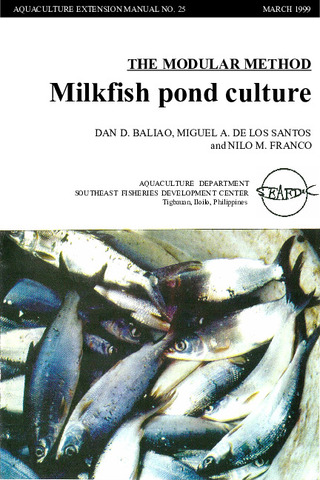Southeast Asian milkfish culture: Economic status and prospects
- Global styles
- MLA
- Vancouver
- Elsevier - Harvard
- APA
- Help

Date
1984Page views
5,490ASFA keyword
AGROVOC keyword
Taxonomic term
Metadata
Show full item record
Share
Abstract
Historically, milkfish (Chanos chanos Forsskal) has been the premier aquaculture product in Indonesia, the Philippines, and Taiwan. However, there are significant differences in the industry's performance among and within these places, especially in terms of yield. These differences can be explained by different factor (land, labor, capital) endowments and by the fact that producers have generally been responsive to these conditions. In Taiwan and the Philippines, milkfish production is becoming less profitable over time. In both places, brackishwater pond producers of milkfish are caught in a cost-price squeeze as input costs have increased more rapidly than market prices. Indonesian producers also face market constraints because high regional transport costs often isolate them from major market centers. In response to declining profitability of milkfish, producers have been changing their production techniques and shifting to the culture of other species such as tilapia that currently have greater domestic or export market potential. Although total milkfish production continues to increase, in the Philippines and Indonesia at least, milkfish's traditional share of total aquaculture production in all these places has declined quite dramatically over the last 10 years, and this trend is likely to continue.
Suggested Citation
Smith, I. R., & Chong, K.-C. (1984). Southeast asian milkfish culture: Economic status and prospects. In J. V. Juario, R. P. Ferraris, & L. V. Benitez (Eds.), Advances in milkfish biology and culture: Proceedings of the Second International Milkfish Aquaculture Conference, 4-8 October 1983, Iloilo City, Philippines. (pp. 1-20). Metro Manila, Philippines: Published by Island Pub. House in association with the Aquaculture Department, Southeast Asian Fisheries Development Center and the International Development Research Centre.
Type
Conference paperISBN
9711007045Collections
Related items
Showing items related by title, author, creator and subject.
-
Series: Aquaculture extension manual; No. 25
The modular method: Milkfish pond culture
Baliao, Dan D.; de los Santos, Miguel A.; Franco, Nilo M. (Aquaculture Department, Southeast Asian Fisheries Development Center, 1999)The modular method of milkfish culture (Chanos chanos) described in the manual is an improvement over the traditional extensive method. The manual is intended for the use of fish farmers and aquaculturists, extensionists, ... -
Evaluation of organic and inorganic fertilizers in brackishwater milkfish ponds
Bombeo-Tuburan, Isidra; Agbayani, Renato F.; Subosa, Precilla F. (Elsevier, 1989)The study was conducted in twelve 144-m2 ponds to evaluate the effect of different organic and inorganic fertilizers on the growth, survival, gross production, and profitability of marketable milkfish. The ... -
Milkfish breeding and hatchery technology at SEAFDEC/AQD
Unknown author (Aquaculture Department, Southeast Asian Fisheries Development Center, 1999)Describes the techniques already adopted by the private sector: broodstock management, broodstock diet, commercial fry production, live transport, and larval diet. A list of AQD research publications on milkfish is included.






